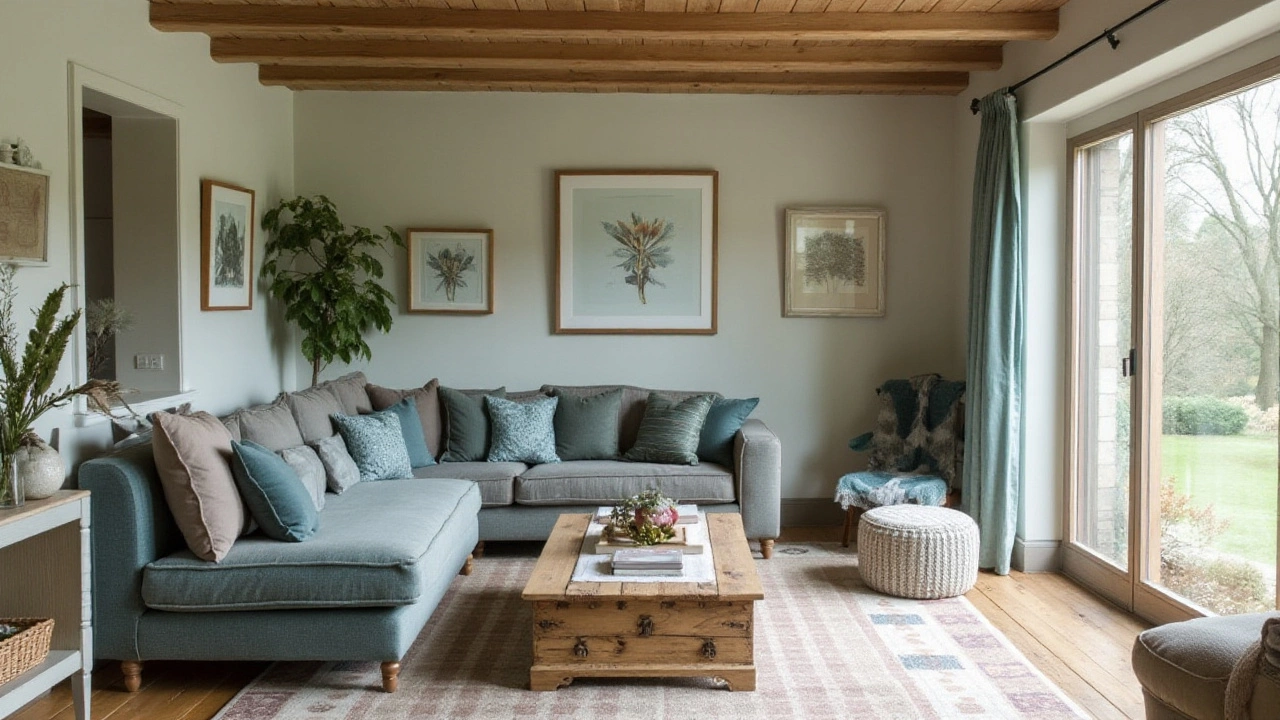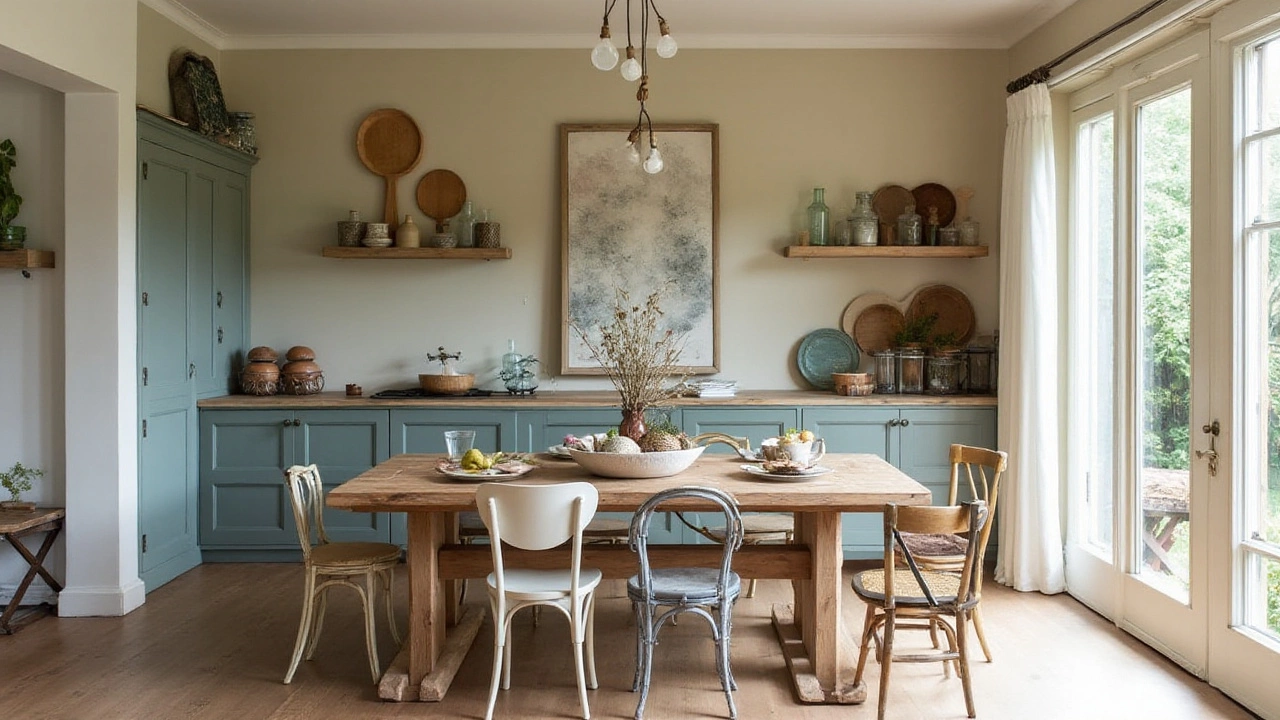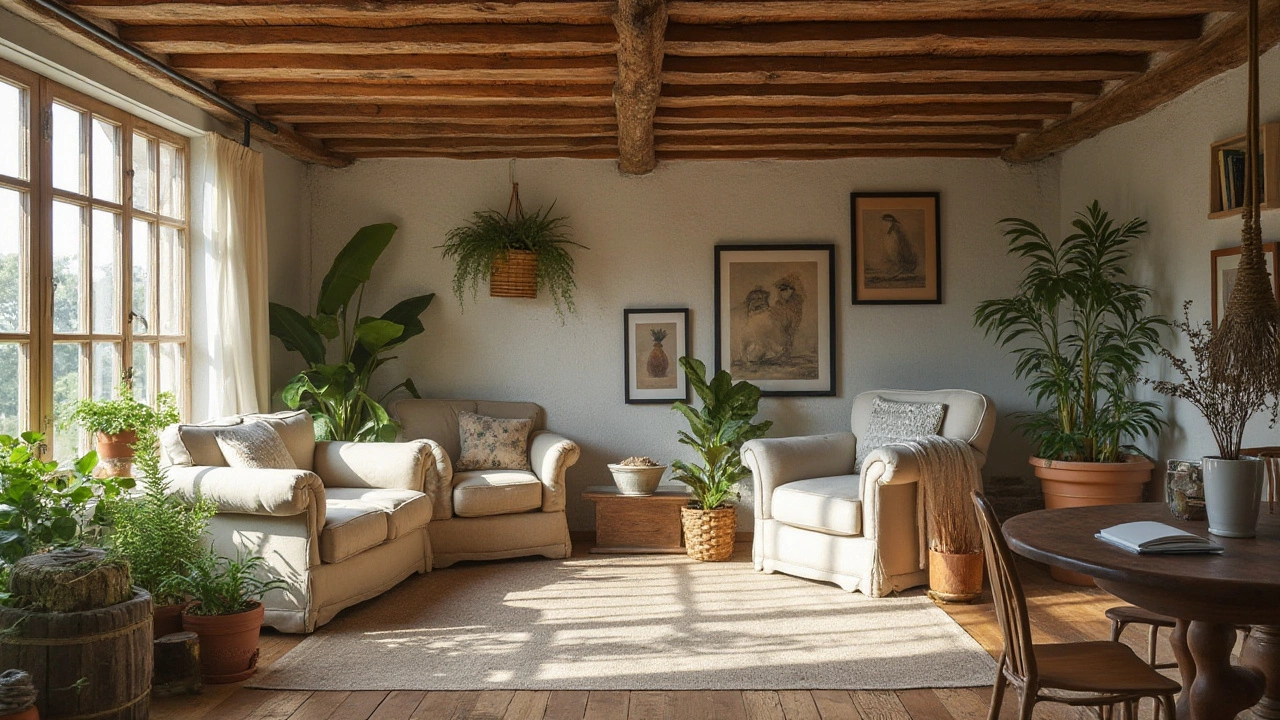The cottage style is making a delightful comeback, and it's evolving into something both familiar and refreshingly new. Imagine a cozy haven that embraces the beauty of rustic charm and blends it harmoniously with modern comforts. This rejuvenated cottage aesthetic doesn't just nod to the past; it creates a timeless space that feels warm and inviting.
As we delve into the heart of this new cottage style, we'll explore the nuances that make it special. From color choices that mirror nature's palette to the clever fusion of old and new decor elements, there's a world of creativity in every corner. Plus, with sustainability gaining importance, the style naturally incorporates eco-friendly practices, ensuring your cottage is as kind to the earth as it is to your soul.
Join us on a journey through the enchanting details that define the new cottage style, where comfort meets modern living and personal touches make your home truly your own.
- Understanding the New Cottage Aesthetic
- Color Palettes and Material Choices
- Incorporating Vintage and Modern Elements
- Sustainable Practices in Cottage Design
- Personalizing Your Cottage Space
Understanding the New Cottage Aesthetic
The new cottage aesthetic is a delightful blend of past and present, a style that captures a sense of nostalgia while embracing contemporary design principles. At its heart, this aesthetic aims to create spaces that feel lived-in and inviting yet remain stylish and functional. The charm of this style lies in its ability to incorporate the gentle, rustic elegance of traditional cottage style with elements that cater to modern sensibilities. What differentiates this style from the cottages of yesteryear is its approach to minimizing clutter and maximizing utility without losing that distinct cozy vibe.
One might ask, what are the defining features of this country cottages inspired style? Well, it often starts with the selection of materials. Natural materials take the spotlight, including reclaimed wood and stone, used in ways that feel both timeless and current. These materials can bring warmth and a sense of history to a space, which is crucial to achieving the right ambiance. The color palette, too, takes cues from nature, often featuring soft, muted tones like sage green, dusty blues, and cream, all of which add to the serene and welcoming atmosphere.
"The new cottage aesthetic celebrates imperfection and authenticity, encouraging us to find beauty in the unpolished and embrace a harmonious blend of old and new," says interior designer Emily Henderson.Upcycling and repurposing are vital parts of this design philosophy, not just because they bring unique character to a home but because they support sustainability in decor—a growing concern for many homeowners today. Embracing vintage or salvaged materials does not mean compromising on aesthetic appeal; rather, it adds to a story that your home quietly tells visitors.
A standout element of this aesthetic is the skilled integration of vintage and modern furnishings. Combining, for instance, a sleek sofa with a distressed wooden coffee table can create balance—a critical tenet of this design approach. Similarly, using vintage textiles such as an old quilt or a plaid blanket can give a nod to the past while pairing it with modern lighting to cast a trendy, soft glow. The art is in the juxtaposition, which keeps the spaces relevant and fresh. A detailed understanding of balance is essential to pulling off rustic decor that neither feels outdated nor too trendy.
Some might say that this style's success lies in its ability to feel personal and flexible. After all, part of its charm is how easily it can be adapted to personal tastes and needs. Whether you want to infuse a little more color or introduce tech-friendly elements, the new cottage style remains accommodating, making it a truly versatile choice for homeowners. Understanding these characteristics will enable you to create a home that radiates warmth, comfort, and charm, much like the cottages that have captivated us throughout history.
Color Palettes and Material Choices
Stepping into the world of the new cottage style, one quickly discovers that color palettes play a critical role in transforming a space into a serene retreat. This contemporary version of cottage style often leans into nature’s hues, with soft, muted tones that bring the outdoors inside. Imagine walls adorned with shades reminiscent of misty mornings, from pale blues and greens inspired by dew-laden fields to gentle earth tones like warm beiges and soft lavenders. These colors are chosen not only for their aesthetic appeal but also for the comforting, calm they evoke in those lucky enough to dwell within.
In crafting a cottage interior, the choice of materials is equally essential. Authenticity and sustainability are at the heart of this decor philosophy, guiding homeowners to select elements that combine durability with charm. Wood, naturally, takes the spotlight, with reclaimed and salvaged timber offering a rustic, historical depth that new materials simply cannot replicate. The grain of aged wood tells its own story, bringing a sense of history and continuity to contemporary spaces. It’s paired beautifully with stone and wrought iron accents, creating a balance of textures that enriches the visual and tactile experience of a country cottage.
Textiles in the new cottage style should harmonize with the chosen color palette, enhancing the overall coziness without overpowering it. Linen and cotton, for example, provide a soft, breathable quality that works well in every season. Slipcovers, curtains, and upholstered furniture should adhere to the subtle color scheme, integrating pastel plaids or floral patterns reminiscent of a country garden. A well-curated selection of handmade rugs, and the occasional vibrant textile, can imbue a sense of crafted authenticity and artisanal skill, drawing attention to the beauty of traditional craftsmanship.
According to interior designer Rachel Ashwell, who popularized the shabby chic aesthetic often overlapping with cottage styles, "The key to creating a warm, inviting country cottage is not in perfection, but in letting each room tell a story, with each piece conveying something about its past." She encourages mixing vintage finds with modern treasures, suggesting that the interplay between the old and new keeps the space both interesting and dynamic. Such advice seems indispensable in tailoring a space that celebrates both history and personal style.
As modern homeowners become more eco-conscious, sustainable materials are no longer just a choice; they’re a statement of ethics. Bamboo and cork are attractive alternatives to traditional flooring, offering sustainable solutions without sacrificing style. Brands are increasingly creating paints that are both eco-friendly and effective, providing a worry-free solution for those aware of their environmental footprint. Choosing such products not only enhances the immediate aesthetic but also ensures that every decision aligns with a commitment to the planet.
To offer a practical application of these ideas, consider using the following materials and color selections to revamp a cottage style kitchen:
- Light oak or reclaimed pine for cabinetry, complemented with brass or wrought iron hardware.
- Walls painted in soft, sunlight-filtered greens or cloudy sky blues.
- A deep farmhouse sink, framed in a gentle marble or terrazzo countertop, mixing durability with visual allure.
- Sustainably sourced linen for window treatments, allowing soft, natural light to permeate the space.

Incorporating Vintage and Modern Elements
Blending vintage and modern elements in cottage style design is both an art and a mindful endeavor. This fusion creates a home that's rich in history yet sharp in contemporary style. Imagine walking into a living space where a time-worn wooden cabinet meets sleek, modern lighting fixtures. Such contrasts create visual interest and provide a platform for personal expression, bringing warmth and liveliness into each room.
One successful approach to this blend is through the use of textiles. Incorporating fabrics with a touch of historical charm—like floral prints reminiscent of Grandma’s attic treasures—can balance more minimalist modern furniture pieces. Upholstery in bold, contrasting colors or patterns can serve as focal points while still paying homage to the essence of traditional country cottage decor. Additionally, vintage rugs with intricate designs can anchor a modern seating arrangement, creating an inviting and cozy space that bridges both worlds.
When it comes to furniture, consider a mix-and-match strategy. Pair an antique dining table with contemporary chairs or utilize a modern sofa with reclaimed wooden side tables. This eclectic style doesn’t follow rigid rules; it's like orchestrating a symphony where every piece plays its own note, yet together they create harmonious music. A report by The British Institute of Interior Design suggests that 73% of interior designers see a shift towards bespoke and personalized spaces, which perfectly aligns with this trend of eclectic mix in interior design.
Art and accessories are another realm where vintage and modern can effortlessly coexist. An elegant Victorian mirror might find its home above a streamlined, modern console table. Or, for a touch of humor and unexpected delight, you might consider something like a whimsical vintage clock adorning an ultra-modern bookshelf. Here is where you can also let photographs and portraits play, mixing old black-and-white family photos with vivid, contemporary art pieces. It's not just about decoration; it's about telling stories.
“The best rooms have something to say about the people who live in them.” – David Hicks, one of the most influential interior designers of the last century.
The principle of sustainability finds its perfect stage here as well. Reuse, repurpose, and recycle are not just eco-friendly options but are at the very heart of creating a home that integrates rustic decor with modernity. Utilitarian items like vintage crates can become shelving solutions, while an old ladder might transform into a stylish magazine rack. Such creativity not only breathes life into discarded items but also adds a special personal touch to the home.
In the grand scope of creating a modern cottage chic residence, remember that mixing rustic and modern isn't about making them blend seamlessly as much as allowing them to stand together confidently. With its nod to heritage and embrace of innovation, this design philosophy encourages a celebration of contrast and cohesion, waiting for you to put your signature touch on it.
Sustainable Practices in Cottage Design
In the heart of the cottage style lies an ever-growing consciousness about living sustainably. More than just a design trend, sustainable living has become a way of life, blending seamlessly with the cozy aesthetics of cottage interiors. The serene environment of country cottages naturally lends itself to incorporating eco-friendly practices. Oftentimes, this starts with the use of reclaimed materials. Whether it’s a beautifully weathered timber beam salvaged from an old barn or recycled brick used for that charming fireplace, each piece tells a story and adds depth to the space without the toll on natural resources.
Energy efficiency is another cornerstone of sustainable cottage design. Modern technology has given us innovative solutions like solar panels and energy-efficient windows, which reduce the carbon footprint without compromising the traditional aesthetics of a cottage. Positioning windows strategically to harness natural light can also reduce reliance on artificial lighting, while creating a warm and inviting atmosphere that's quintessentially cottage-like. Moreover, adding thick rugs and heavy drapes not only touches on that rustic feel but also provides insulation, which helps maintain comfortable indoor temperatures throughout the year.
Sourcing locally made or second-hand furniture is both an environmentally and economically wise choice. By opting for these pieces, homeowners not only support local artisans and vendors but also reduce the environmental impact associated with transporting new furniture across long distances. A well-chosen vintage armchair or a handwoven throw adds personality to your home, mixing modernity with a country cottage soul. Incorporating sustainable textiles, such as organic cotton or linen, further enhances the eco-friendly nature of the cottage, making it elegant and soft to the touch.
"Sustainability is not just about doing less harm. It's about doing more good." – Jochen ZeitzAs the world grows more environmentally conscious, it becomes vital to extend the consideration of sustainability to the outdoors as well. Embracing native plants in your garden reduces the need for excessive watering and chemical treatments, allowing the vibrant energy of nature to flourish. Rainwater collection systems or compost bins can easily be integrated into the garden's design, providing natural irrigation and reducing household waste. These steps create a positive cycle of sustainability that harmonizes effortlessly with the rhythm of a cottage style home.
Finally, sustainable design extends to a mindful lifestyle, encouraging those living in country cottages to cherish what they have and think intentionally about new acquisitions. It's about choosing quality over quantity, valuing craftsmanship, and remembering the beauty in simplicity. By thoughtfully adopting these sustainable practices, a cottage’s design will not only remain timeless but also a true reflection of a home where the earth is as much a part of its charm as the cozy interiors themselves.

Personalizing Your Cottage Space
Creating a space that feels uniquely yours within the broad theme of cottage style is an art form that combines personal sentiments with creative flair. In today’s eclectic blend of rustic and modern, personalizing your cottage goes beyond simple decoration. It’s about crafting an environment that resonates with your identity and daily life. Start by selecting decor that speaks to you—perhaps an heirloom quilt from your grandmother or a handwoven rug picked up during your travels. These pieces imbue warmth and narrative, transforming your cottage into a living story of your experiences and tastes.
Moreover, the color palette plays a crucial role in personalization. While traditional cottages often leaned towards pastel shades, the new cottage style embraces bolder hues. Consider a rich, dark green accent wall, which can evoke verdant forests, or perhaps a sunny yellow to mimic the glow of a summer morning. Incorporating a tapestry of colors not only brightens the space but allows your personality to shine through. Don’t restrict yourself to paint alone; explore textiles and accessories that coordinate or contrast to create visual interest and depth.
Integrating artisanal crafts and bespoke furniture can set your cottage apart. Support local artisans or even take up a crafting hobby yourself; the connection to these handmade items adds emotional value. One of Ireland's renowned interior designers, Orla Kiely, emphasizes the importance of these personal touches in home decor:
“A home is more than its structure—it’s the life lived within it, reflected through personal treasures and memories.”Take this wisdom to heart by selecting pieces that tell your stories, whether they’re crafted by your hands or those of local talents.
The pursuit of sustainability also offers personalization opportunities. Repurpose vintage furniture or embark on DIY projects. Transform an old wooden ladder into a charming bookshelf or a vintage crate into a coffee table—these unique fixtures not only give old items new life but also add a personal stamp that’s both stylish and eco-conscious. Embracing sustainability in decoration means you're not merely following a trend; you're partaking in a lifestyle that reflects values of creativity and responsibility.
Last but certainly not least, your floor space can tell a tale of countryside bliss. Enrich it with layers, such as throw rugs on hardwood floors, to add texture and cushion. The small architectural features like window sills or alcoves can become showcases for small potted plants, a collection of vintage finds, or beloved books. These nuanced touches personalize your space, creating an environment that is comforting and entirely yours.
Finally, let nature play a role in your space. Utilize natural light to highlight corners of your room where cherished photographs or unique artifacts reside. Consider placing windows or sky-facing areas at vantage points to maximize sunlight. Whether your view is a sprawling countryside or a simple backyard garden, connect the indoors with the outside for an experience of serenity and expansion, characteristic of true country cottages. The marriage of light, personal items, and color transforms your cottage into more than just a home; it becomes your bespoke sanctuary.
